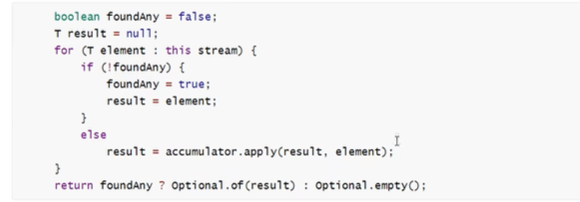java_stream
本文最后更新于:1 年前
1.lambda表达式
1.1 概述
Lambda是JDK8的语法糖。可以对某些匿名内部类的写法进行简化。是函数式编程的重要体现,不用关心是什么对象,而是更加关注对数据进行什么操作
1.2 核心原则
可推导可省略
1.3 基本格式
(参数列表) -> {代码}例子
针对只有一个抽象方法的匿名内部类
new Thread(new Runnable() {
@Override
public void run() {
System.out.println("hello world!");
}
}).start();
new Thread(() -> System.out.println("hello world!")).start();
public static int calculate(IntBinaryOperator operator){
int a = 10;
int b = 20;
return operator.applyAsInt(a, b);
}
int calculate = calculate(new IntBinaryOperator() {
@Override
public int applyAsInt(int left, int right) {
return left + right;
}
});
int calculate = calculate((a, b) -> a + b);
int calculate = calculate(Integer::sum);public static void intPrint(IntPredicate intPredicate){
int[] arr = {1, 2, 3, 4, 5, 6};
for (int i : arr) {
if(intPredicate.test(i)){
System.out.println(i);
}
}
}
intPrint(new IntPredicate() {
@Override
public boolean test(int value) {
return value % 2 == 0;
}
});
intPrint( (value -> {
return value % 2 == 0;
}));public static <R> R typeCover(Function<String, R> function){
String str = "12345";
R result = function.apply(str);
return result;
}
Integer integer = typeCover(new Function<String, Integer>() {
@Override
public Integer apply(String s) {
return Integer.valueOf(s);
}
});
Integer integer1 = typeCover((s) -> {
return Integer.valueOf(s);
});
System.out.println(integer);public static void foreachArr(IntConsumer intConsumer){
int[] arr = {1, 2, 3, 4, 5, 6};
for (int i : arr) {
intConsumer.accept(i);
}
}
foreachArr(new IntConsumer() {
@Override
public void accept(int value) {
System.out.println(value + 2);
}
});
foreachArr((value -> {
System.out.println(value + 2);
}));
foreachArr(System.out::println);1.4 省略规则
参数类型可以省略
方法体只有一句代码时大括号return和唯一一句代码的分号可以省略
方法只有一个参数时小括号可以省略
以上这些规则都记不住也可以省略不记
2.stream
2.1 概述
Java8的Stream使用的是函数式编程模式,如同它的名字一样,它可以被用来对集合或数组进行链状流式的操作。可以更方便的让我们
对集合或数组操作。
2.2 数据准备
@Data
@AllArgsConstructor
@NoArgsConstructor
@EqualsAndHashCode
public class Author {
private Long id;
private String name;
private String introduction;
private Integer age;
private List<Book> bookList;
}@Data
@AllArgsConstructor
@NoArgsConstructor
@EqualsAndHashCode
public class Book {
private Long id;
private String category;
private String name;
private Double score;
private String introduction;
}// 初始化一些数据
private static List<Author> getAuthors() {
Author author1 = new Author(1L, "杨杰炜", "my introduction 1", 18, null);
Author author2 = new Author(2L, "yjw", "my introduction 2", 19, null);
Author author3 = new Author(3L, "yjw", "my introduction 3", 14, null);
Author author4 = new Author(4L, "wdt", "my introduction 4", 29, null);
Author author5 = new Author(5L, "wtf", "my introduction 5", 12, null);
List<Book> books1 = new ArrayList<>();
List<Book> books2 = new ArrayList<>();
List<Book> books3 = new ArrayList<>();
// 上面是作者和书
books1.add(new Book(1L, "类别,分类啊", "书名1", 45D, "这是简介哦"));
books1.add(new Book(2L, "高效", "书名2", 84D, "这是简介哦"));
books1.add(new Book(3L, "喜剧", "书名3", 83D, "这是简介哦"));
books2.add(new Book(5L, "天啊", "书名4", 65D, "这是简介哦"));
books2.add(new Book(6L, "高效", "书名5", 89D, "这是简介哦"));
books3.add(new Book(7L, "久啊", "书名6", 45D, "这是简介哦"));
books3.add(new Book(8L, "高效", "书名7", 44D, "这是简介哦"));
books3.add(new Book(9L, "喜剧", "书名8", 81D, "这是简介哦"));
author1.setBookList(books1);
author2.setBookList(books2);
author3.setBookList(books3);
author4.setBookList(books3);
author5.setBookList(books2);
return new ArrayList<>(Arrays.asList(author1, author2, author3, author4, author5));
}2.3 快速入门
2.3.1 需求
我们可以调用getAuthors方法获取到作家的集合。现在需要打印所有年龄小于18的作家的名字,并且要注意去重。
2.3.2 实现
/**
* 我们可以调用getAuthors方法获取到作家的集合。现在需要打印所有年龄小于18的作家的名字,并且要注意去重。
*/
public static void test1(){
List<Author> authors = getAuthors();
authors.stream().distinct() //去重
.filter(author -> author.getAge() < 18)
.forEach(author -> System.out.println(author.getName()));
}
2.4 常用操作
2.4.1 创建流
单列集合:集合对象.stream()
List<Author> authors = getAuthors();
Stream<Author> stream = authors.stream();数组: Arrays.stream(数据)或者使用Stream.of创建
Integer[] arr = {1, 2, 3};
Stream<Integer> stream = Arrays.stream(arr);
Stream<Integer> arr1 = Stream.of(arr);双列集合:转换为单列集合后创建
HashMap<String, String> map = new HashMap<>();
map.put("111", "111");
map.put("222", "222");
Stream<Map.Entry<String, String>> stream1 = map.entrySet().stream();2.4.2 中间操作
filter
可以对流中的元素进行条件过滤,符合条件的才能继续留在流中。
例子:
打印所有姓名长度大于2的作家姓名
authors.stream().distinct() //去重
.filter(author -> author.getAge() < 18)
.forEach(author -> System.out.println(author.getName()));map
对元素进行计算或转换
打印所有作家的姓名
List<Author> authors = getAuthors();
Stream<Author> stream = authors.stream();
stream.map(new Function<Author, String>() {
@Override
public String apply(Author author) {
return author.getName();
}
}).forEach(name -> System.out.println(name));
authors.stream()
.map(author -> author.getName())
.forEach(name -> System.out.println(name));
authors.stream()
.map(Author::getName)
.forEach(System.out::println);dictinct
对流中的元素进行去重操作
注意: distinct方法是依赖Object的equals方法来判断是否是相同对象的。所以需要注意重新equals方法。
例子
打印所有作家的姓名,不能包含重复的元素
List<Author> authors = getAuthors();
authors.stream()
.distinct()
.forEach(author -> System.out.println(author.getName())sorted
对流中的元素按照规则进行排序
注意:如果调用空参sorted()方法,需要流中的元素实现了Comparable接口
例子
按照年龄排序,并且不能有重复的元素
升序排序
authors.stream()
.distinct()
.sorted(new Comparator<Author>() {
@Override
public int compare(Author o1, Author o2) {
return o1.getAge() - o2.getAge();
}
})
.forEach(author -> System.out.println(author.getAge()));
authors.stream()
.distinct()
.sorted((o1, o2) -> o1.getAge() - o2.getAge())
.forEach(author -> System.out.println(author.getAge()));
authors.stream()
.distinct()
.sorted(Comparator.comparingInt(Author::getAge)) // 默认是升序排序
.forEach(author -> System.out.println(author.getAge()));降序排序
authors.stream()
.distinct()
.sorted((o1, o2) -> o2.getAge() - o1.getAge())
.forEach(author -> System.out.println(author.getAge()));limit
可以限制流的最大长度,超出部分将被抛弃
例如:
对流中的元素按照年龄进行降序排序,并且要求不能有重复的元素,然后打印其中年龄最大的两个作家的姓名。
List<Author> authors = getAuthors();
authors.stream()
.distinct()
.sorted((o1, o2) -> o2.getAge() - o1.getAge())
.limit(2)
.forEach(author -> System.out.println(author.getName()));
skip
跳过流中的前n个元素,处理剩下的元素
例子
打印除了年龄最大的作家外的其他作家,要求不能有重复元素,并且按照年龄降序排序
List<Author> authors = getAuthors();
authors.stream()
.distinct()
.sorted((o1, o2) -> o2.getAge() - o1.getAge())
.skip(1)
.forEach(System.out::println);flatMap
map只能将一个对象转换成另一个对象来作为流中的元素,而flatMap可以把一个对象转换成多个对象作为流中的元素
例一
打印所有书籍名字,要求对重复的元素进行去重
authors.stream()
.distinct()
.flatMap(new Function<Author, Stream<Book>>() {
@Override
public Stream<Book> apply(Author author) {
return author.getBookList().stream();
}
})
.distinct()
.forEach(new Consumer<Book>() {
@Override
public void accept(Book book) {
System.out.println(book.getName());
}
});
authors.stream()
.distinct()
.flatMap(author -> author.getBookList().stream())
.distinct()
.forEach(book -> System.out.println(book.getName()));例二:
打印现有数据的所有分类。要求对分类进行去重。不能出现这种格式:哲学,爱情
authors.stream()
.distinct()
.flatMap(author -> author.getBookList().stream())
.distinct()
.flatMap(book -> Arrays.stream(book.getCategory().split(",")))
.distinct()
.forEach(System.out::println);2.4.3 终结操作
forEach
对流中的元素进行遍历操作,我们通过传入的参数去指定对追历到的元素进行什么具体操作。
上面的例子中一直在使用,就不在赘述
count
获取当前流中元素的个数
例子
打印这些作家所处书籍的数量,删除重复元素
long count = authors.stream()
.distinct()
.flatMap(author -> author.getBookList().stream())
.distinct()
.count();
System.out.println(count);max&min
计算流中元素的最值
例子
分别获取作家所出书籍的最高分和最低分并打印
Optional<Double> max = authors.stream()
.distinct()
.flatMap(author -> author.getBookList().stream())
.distinct()
.map(book -> book.getScore())
.max(new Comparator<Double>() {
@Override
public int compare(Double o1, Double o2) {
if (o1 - o2 > 0) {
return 1;
} else if (o1 < o2) {
return -1;
} else {
return 0;
}
}
});
Optional<Double> min = authors.stream()
.distinct()
.flatMap(author -> author.getBookList().stream())
.distinct()
.map(book -> book.getScore())
.min((o1, o2) -> {
if (o1 - o2 > 0) {
return 1;
} else if (o1 < o2) {
return -1;
} else {
return 0;
}
});
System.out.println(max.get());
System.out.println(min.get());collect
把当前流转换成集合
例子
获取一个存放作者名字的集合
List<Author> authors = getAuthors();
List<String> nameList = authors.stream()
.distinct()
.map(Author::getName)
.collect(Collectors.toList());
System.out.println(nameList);获取所有书名的Set集合
Set<String> nameList = authors.stream()
.distinct()
.flatMap((Function<Author, Stream<Book>>) author -> author.getBookList().stream())
.map(Book::getName)
.collect(Collectors.toSet());
System.out.println(nameList);获取一个Map集合,key为作者名,value为List<Book>
Map<String, List<Book>> map = authors.stream()
.distinct()
.collect(Collectors.toMap(new Function<Author, String>() {
@Override
public String apply(Author author) {
return author.getName();
}
}, new Function<Author, List<Book>>() {
@Override
public List<Book> apply(Author author) {
return author.getBookList();
}
}));
map.forEach((key, value) -> System.out.println(key + ":" + value));
Map<String, List<Book>> map = authors.stream()
.distinct()
.collect(Collectors.toMap(Author::getName, Author::getBookList));
map.forEach((key, value) -> System.out.println(key + ":" + value));查找与匹配
anyMatch
可以用来判断是否有任意匹配符合匹配条件按的元素,返回结果是Boolean类型
例子判断是否有年龄在29岁以上的作家
boolean anyMatch = authors.stream().distinct()
.anyMatch(author -> author.getAge() > 30);allMatch
可以用来判断是否都符合匹配条件,结果为boolean类型。如果都符合结果为true,否则结果为false。
boolean allMatch = authors.stream().distinct()
.allMatch(author -> author.getAge() > 10);noneMatch
可以判断流中元素是否都不符合匹配条件,如果都不符合返回true,否则返回false
boolean noneMatch = authors.stream().distinct()
.noneMatch(author -> author.getAge() > 100);findAny
获取流中任意一个元素,该方法没有办法保证获取的一定是流中的第一个元素
例子
获取任意一个大于18的作家,如果存在就输出他的名字
Optional<Author> authorOptional = authors.stream().distinct()
.filter(author -> author.getAge() > 18)
.findAny();
authorOptional.ifPresent(author -> System.out.println(author.getName()));findFirst
获取流中任意一个元素,该方法保证获取的一定是流中的第一个元素
例子
获取年龄最小的作家,如果存在就输出他的名字
Optional<Author> authorOptional = authors.stream().distinct()
.sorted((o1, o2) -> o1.getAge() - o2.getAge())
.findFirst();
authorOptional.ifPresent(author -> System.out.println(author.getName()));reduce归并
对流中的教据按照你指定的计算方式计算出一个结果。(缩减操作)
reduce的作用是把stream中的元素给组合起来,我们可以传入一个初始值,它会按照我们的计算方式依次拿流中的元素和在初始化值的基础上进行计算,计算结果再和后面的元素计算。
例子
使用reduce操作求出所有作家的年龄的和
Integer sum = authors.stream()
.map(Author::getAge)
.reduce(0, (result, element) -> result + element);
System.out.println(sum);使用reduce求所有作者中年龄的最大值
Integer max = authors.stream()
.map(Author::getAge)
.reduce(Integer.MIN_VALUE, new BinaryOperator<Integer>() {
@Override
public Integer apply(Integer result, Integer element) {
return result > element ? result : element;
}
});使用reduce求所有作者中年龄的最小值
Integer min = authors.stream()
.map(Author::getAge)
.reduce(Integer.MAX_VALUE, new BinaryOperator<Integer>() {
@Override
public Integer apply(Integer result, Integer element) {
return result < element ? result : element;
}
});reduce一个参数的重载形式内部计算

2.5 注意事项
- 惰性求值(如果没有终结操作,没有中间提作是不会得到执行的)
- 流是一次性的 (一旦一个流对象经过一个终结操作后这个流就不能再被使用)
- 不会影响原数据(我们在流中可以多数据做很多处理。但是正常情况下是不会影响原来集合中的元素的。这往往也是我们期望的)
3. Optional
3.1 概述
我们在编写代码的时候出现最多的就是空指针异常。所以在很多情况下我们需要做各种非空的判断。
尤其是对象中的属性还是一个对象的情况下。这种判断会更多。而过多的判断语句会让我们的代码显得臃肿不堪。所以在IDK8中引入了Optional,养成使用Optional的习惯后你可以写出更优雅的代码来避免空指针异常并且在很多函数式编程相关的AP中也都用到了Optional,如果不会使用Optional也会对函数式编程的学习造成影响。
3.2 使用
3.2.1 创建对象
Optional就像是包装类,可以将我们的具体数据封装到Optional内部。然后使用optional获取数据可以非常优雅的避免空指针异常。
一般使用Optional的静态方法ofNullable把数据封装成一个Optional对象。无论传入的参数是否为null都不会出现问题
List<Author> authors = getAuthors();
Optional<List<Author>> optionalAuthors = Optional.ofNullable(authors);你可能会觉得还要加一行代码来封装数据比较麻烦。但是如果改造下getAuthor方法,让其的返回值就是封装好的Optional的话,我们在使用时就会方便很多。
而且在实际开发中我们的数据很多是从数据库获取的。Mybatis从3.5版本可以也已经支持ptional了。我们可以直接把dao方法的返回值类型定义成Optional类型,MyBastis会自己把数据封装成Optional对象返回。封装的过程也不需要我们自己操作。
如果你确定一个对象不是空的则可以使用Optional的静态方法of来把数据封装成Optional对象。
Optional<List<Author>> optionalAuthors = Optional.of(authors);如果一个方法的返回值是Optional类型,而如果经过我们判断后,发现返回值为null,这时候需要将null封装成Optional对象返回。需要调用Optional的静态方法empty()进行封装
Optional.empty()3.2.2 安全消费数据
我们获取到一个Optional对象后肯定需要对其中的数据进行使用。这时候我们可以使用其ifPresent方法对来消费其中的值.
这个方法会判断其内封装的数据是否为空,不为空时才会执行具体的消费代码。这样使用起来就更加安全了。
例如,以下写法就优雅的避免了空指针异常。
Optional<List<Author>> optionalAuthors = Optional.of(authors);
optionalAuthors.ifPresent(authors1 -> System.out.println(authors1.size()));3.2.3 获取值
直接使用get()函数即可获取被封装的数据,但是当存入的数据是null时,会出现异常
3.2.4 安全地获取值
如果我们期望安全的获取值。我们不推荐使用get方法,而是使用Optional提供的以下方法。
orElseGet
获取数据并且设置数据为空时的默认值。如果数据不为空就能获取到该数据。如果为空则根据你传入的参数来创建对象作为默认值返回。
Optional<Author> authoroptional = optional.ofNullable(getAuthor());
authoroptional.filter(author -> author,getAge()>100)ifpresent(author ->system.out.print1n(author .getName()));orElseThrow
获取数据,如果数据不为空就能获取到该数据。如果为空则根据你传入的参数来创建异常抛出。
3.2.5 过滤
我们可以使用filter方法对数据进行过滤。如果原本是有数据的,但是不符合判断,也会变成一个无数据的Optional对象。
3.2.6 判断
我们可以使用isPresent方法进行是否存在数据的判断。如果为空返回值为false,如果不为空,返回值为true。但是这种方式并不能体现
Optional的好处,更推荐使用ifPresent方法。
3.2.7 数据转换
Optional还提供了map可以让我们的对数据进行转换,并且转换得到的数据也还是被Optional包装好的,保证了我们的使用安全。
例如我们想获取作家的书籍集合。
4.函数式接口的常用方法
and
在使用predicate接口时,可能需要进行条件的拼接。and方法就相当于&&符号实现拼接两个判断条件
例如
打印作家中年龄大于17并且姓名长度大于2的作家
List<Author> authors = getAuthors();
authors.stream().filter(new Predicate<Author>() {
@Override
public boolean test(Author author) {
return author.getAge() > 17;
}
}.and(new Predicate<Author>() {
@Override
public boolean test(Author author) {
return author.getName().length() > 2;
}
})).forEach(System.out::println);
authors.stream().filter(((Predicate<Author>) author -> author.getAge() > 17).and(author -> author.getName().length() > 2)).forEach(System.out::println);
or
而or方法相当于是使用||来拼接两个判断条件。
例子
打印作家中年龄大于17或者姓名长度大于2的作家
authors.stream().filter(((Predicate<Author>) author -> author.getAge() > 17).or(author -> author.getName().length() > 2)).forEach(System.out::println);
negat
就是取反操作,相当于!
5.stream的高级用法
基本数据类型优化
之前用到的很多Stream的方法由于都使用了泛型。所以涉及到的参数和返回值都是引用数据类型。
即使我们操作的是整教小数,但是实际用的都是他们的包装类。IDK5中引入的自动装箱和自动拆箱让我们在使用对应的包装类时就好像使用基本数据类型一样方便。但是你一定要知道装箱和拆箱肯定是要消耗时间的。虽然这个时间消耗很下。但是在大量的数据不断的重复装箱拆箱的时候,你就不能无视这个时间损耗了
所以为了让我们能够对这部分的时间消耗进行优化。Stream还提供了很多专门针对基本数据类型的方法。例如: mapTolnt,mapToLong,mapToDouble,flatMapTolnt,flatMapToDouble等
authors.stream()
.map(Author::getAge)
.map(age -> age + 10)
.filter(age -> age > 18)
.forEach(System.out::println);
authors.stream()
.mapToInt(Author::getAge)
.map(age -> age + 10)
.filter(age -> age > 18)
.forEach(System.out::println);并行流
当流中有大量元素时,我们可以使用并行流去提高操作的效率。其实并行流就是把任务分配给多个线程去完全。如果我们自己去用代码实现的话其实会非常的复杂,并且要求你对并发编程有足够的理解和认识。而如果我们使用Stream的话,我们只需要修改一个方法的调用就可以使用并行流来帮我们实现,从而提高效率。
authors.stream().parallel()
.peek(new Consumer<Author>() {
@Override
public void accept(Author author) {
System.out.println(author.getName() + Thread.currentThread().getName());
}
})
.map(Author::getAge)
.map(age -> age + 10)
.filter(age -> age > 18)
.forEach(System.out::println);
authors.parallelStream()
.peek(new Consumer<Author>() {
@Override
public void accept(Author author) {
System.out.println(author.getName() + Thread.currentThread().getName());
}
})
.map(Author::getAge)
.map(age -> age + 10)
.filter(age -> age > 18)
.forEach(System.out::println);本博客所有文章除特别声明外,均采用 CC BY-SA 4.0 协议 ,转载请注明出处!
